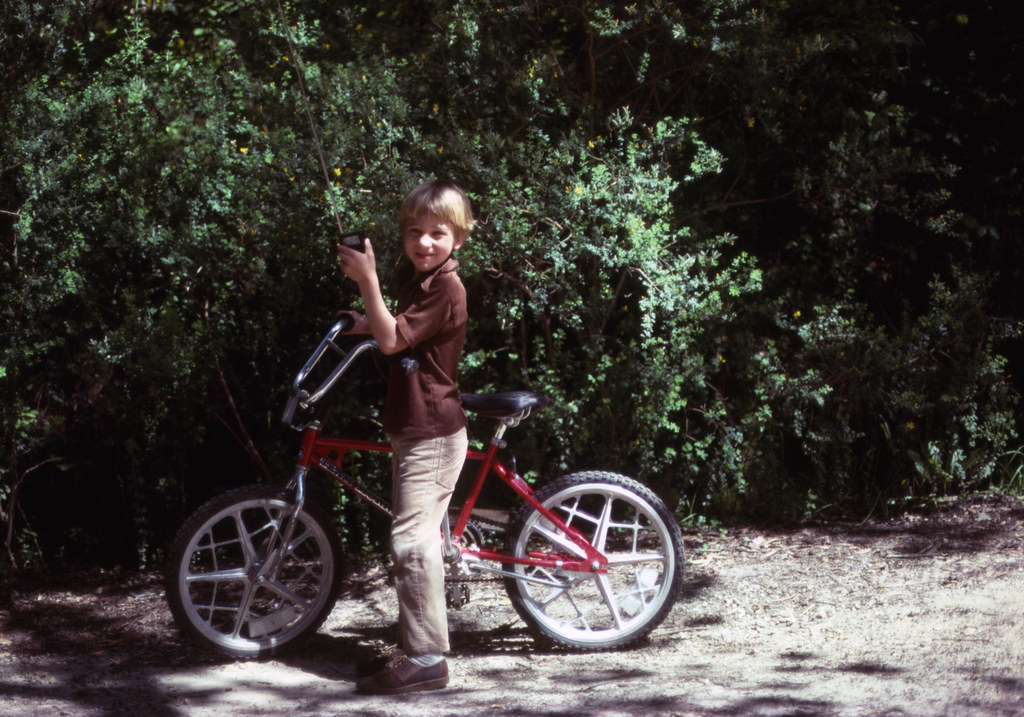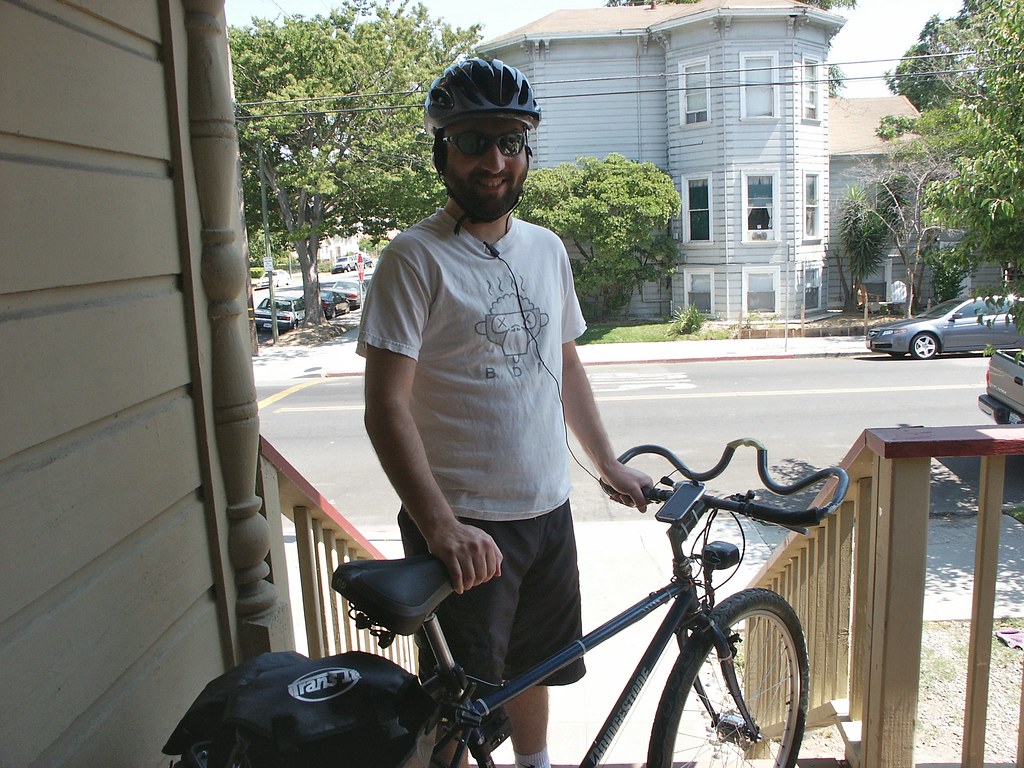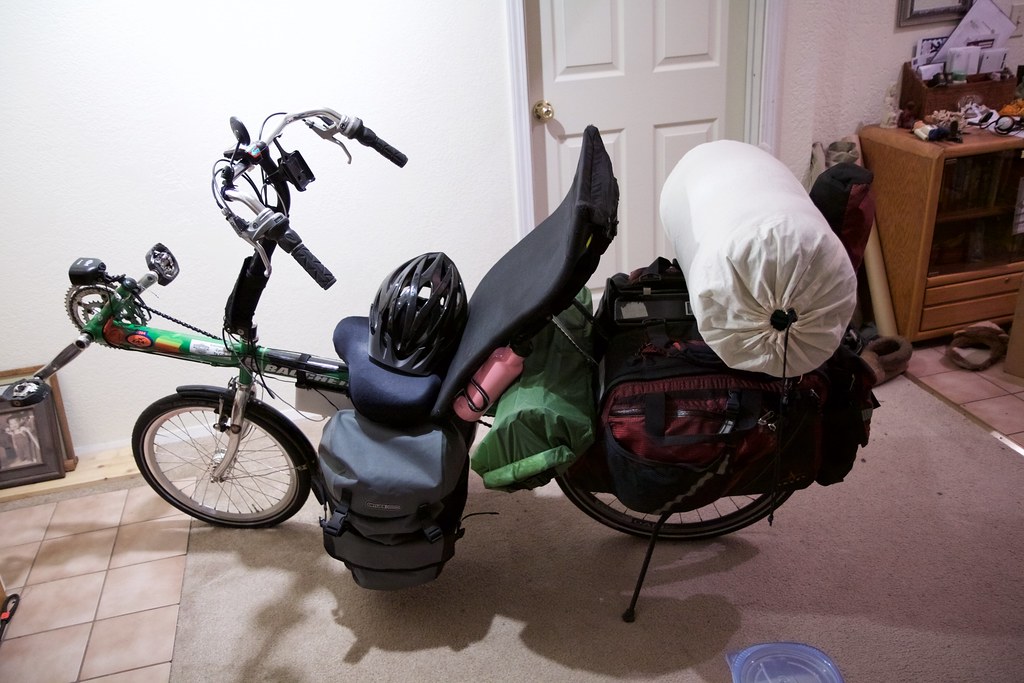Powering Stuff On A Long Bike Tour
I’ve been doing long bike tours for over 15 years now, and for almost all of them I’ve carried a laptop so I can compute on the road, including pretty serious remote work as a software developer.
The metaphorical landscape has changed massively since I started doing this. All the tools have gotten way better. But one of the challenges I am constantly dealing with is: How the heck do you power and charge everything?
I’m always looking for ways to make my solution better, but I’ve hit on a nice one just now, and after going on a few trips to test it out, I figure I should pause here and document it for my own obsessive reference.
These are the two main parts:
To go with these, I have a set of cables:
- A set of four short USB-C cables from CableCreation that support data and up to 60 watts of power.
- A couple of adapters that turn any USB-C connector into a Micro-USB or Lightning connector.
- Two 2-meter USB-C cables that support up to 100 watts of power. (One of them is the magsafe cable that comes with my laptop.)
Here’s what makes this setup so good:
The HyperJuice battery can charge itself and three other USB-C devices while it is recharging.
For example, after a day of working in some remote place and draining the battery, you can plug the battery into the Anker 737 and it will charge at 100 watts. Then at the same time you can plug in three other things, like your phone and GPS and headphones, and charge those as you go. These gadgets will charge at full speed and the battery will charge as well.
So all you need is one power socket. That’s important when you’re traveling in weird places, and power sockets are often in high demand. Here’s another thing you can do:
Plug the other long cable into the Anker 737, and the battery park charges at 60 watts, while your laptop also charges at 60 watts. (Yes, this one adapter will put out 120 watts for you. I’ve done this a hundred times.) Now if you want, you can plug more things into your laptop and charge those as well. So with one socket you can charge your battery, your laptop, and six other devices, all at once. No swapping required.
My typical hotel room charging list is:
- Laptop
- HyperJuice Battery
- Secondary smaller battery
- iPhone
- Airpods Pro
- GPS unit
- Camera battery
- Portable speakers
With this setup, I can plug all these in and just walk away.
Another thing you can do with this adapter is, if someone else is claiming the only power socket in a place, you can offer to use yours instead. Since it has two USB-C outlets, you both can plug into it and share the socket at full power.
I’ve done exactly that in a few very crowded cafes.
Also, I only ever need one international adapter.
And, in situations where the power socket is very far away, I can use the battery between the two cables, making one 4-meter (13-foot) long cable.
By putting velcro patches on my small items (external drive, media card reader) I can use the short cables to stick them on the back of my laptop while they’re connected, keeping them nicely out of the way.
Altogether it’s a great setup. It’s extremely flexible, charges lots of things, provides a ton of backup power (good for using the laptop all day at a campsite), and in situations where time is limited, I can store up the maximum amount of energy by charging the battery at 100 watts … or the laptop and battery at a combined 120 watts.
Second Life
February 12, 2023 Filed under Inspiration
Your second life begins when you realize you only have one.
Raphaelle Giordano
Valoria parts list
Valoria has evolved a bit since I first built her. This list is up-to-date as of January 2023.
| Part | Cost | Last Seen At |
|---|---|---|
| aMTBer 20T Chainring 64 BCD | $40 | Amazon |
| Avid BB7 160mm MTB rotor disc brake #1 | $81 | Modern Bike |
| Avid BB7 160mm MTB rotor disc brake #2 | $81 | Modern Bike |
| Avid Speed Dial 7 Bicycle Brake Lever Set | $28 | Modern Bike |
| Bacchetta 20” Carbon Johnson Fork | $300 | Bacchetta |
| Bacchetta Compression Plug for Carbon Fork | $12 | Bacchetta |
| Orbit X Crown Race 1-1/8in | $7 | Bacchetta |
| Bacchetta Giro A20 frame kit, large, with Bella riser, 13” lower seat stays, 21” wide handlebar | $800 | Zach Kaplan |
| Bacchetta Giro A20 rear wheel without tire, tube, or cassette | $120 | Zach Kaplan |
| Bacchetta Recurve seat | $275 | Zach Kaplan |
| Aluminum Handlebar Cup Holder | $14 | Amazon |
| Busch & Müller 95cm headlight cable & 210cm taillight cable, with connectors on both ends | $10 | Zach Kaplan |
| Busch & Müller Lumotec IQ-X Dynamo Headlight with coax connector | $223 | Perennial Cycle |
| Busch & Müller TopLight Line Plus taillight | $44 | Zach Kaplan |
| Busch & Müller Cycle Star Mirror 903 long curved Rod | $37 | Amazon |
| Igaro D2 Pro R3 Dynamo USB Power Converter with coax connector | $218 | Perennial Cycle |
| FSA Orbit MX 1-1/8″ headset | $78 | Bacchetta |
| Jagwire Mountain Brake Inner Wire Slick Stainless, 1.5X2750mm #1 | $12 | Amazon |
| Jagwire Mountain Brake Inner Wire Slick Stainless, 1.5X2750mm #2 | $12 | Amazon |
| KMC 9-speed chain | $65 | Zach Kaplan |
| Microshift FD-R439 Front Derailleur | $26 | Modern Bike |
| Pinhead Bicycle Locking Skewer Set | $43 | Amazon |
| Pitstop SS Tandem Shift Cable (3100mm) #1 | $9 | Amazon |
| Pitstop SS Tandem Shift Cable (3100mm) #2 | $9 | Amazon |
| Quad Lock Cycling – Handlebar/Stem Mount #1 | $30 | Quad Lock |
| Quad Lock Cycling – Handlebar/Stem Mount #2 | $30 | Quad Lock |
| Quad Lock Cycling – Handlebar/Stem Mount #3 | $30 | Quad Lock |
| Schwalbe Marathon Mondial Touring Bike Tire, 26 x 2.0in | $90 | Schwalbe |
| Schwalbe Marathon Plus HS Wire Tire, 20 x 1.75in | $50 | Schwalbe |
| Shimano Alivio FC-M4050 Crankset 170mm 40X30X22t | $66 | eBay |
| Shimano HG400 CS-HG400-9 9 Speed Cassette, 12-36 | $41 | Modern Bike |
| Shimano PD-EH500 SPD & Flat Dual Sided Bike Pedals | $77 | Amazon |
| SONdelux Disc hub, 32-hole | $309 | Zach Kaplan |
| SON Junction Box with SON Hub Adapter | $70 | Perennial Cycle |
| Splined to 6-bolt adaptor for SONdelux | $25 | Zach Kaplan |
| SRAM X.7 9-Speed Rear Derailleur, Long Cage | $59 | Walmart |
| SRAM X0 Bicycle Twist Shifter Set (9-Speed) | $73 | Amazon |
| TerraCycle GlideFlex Stem, 1-1/8″ lower clamp, 1-1/8″ upper mast | $135 | Zach Kaplan |
| TerraCycle Multi-Purpose Accessory Mount, 75 mm x 100 mm arms, 1-1/8″ clamps | $38 | Zach Kaplan |
| TerraCycle Tab Mount For Euro Style Lights | $9 | Zach Kaplan |
| TerraCycle Fastback NorBack Frame Pack | $105 | TerraCycle |
| Tonyon four-segment anti-shear bicycle lock TY3869-20 | $30 | AliExpress |
| Topeak Road Morph G Bike Pump with Gauge | $28 | Amazon |
| Topeak Fuel Tank with Charging Cable Hole (Large) | $40 | Amazon |
| TRP Front Flat Mount Fork to Post Mount Caliper Adaptor for 160mm Rotors with two 17mm Bolts | $12 | Modern Bike |
| Tubus Cargo Evo Classic Rear Bicycle Rack | $104 | Amazon |
| Velocity Aeroheat/Dyad 20 x 1.5″ 32 Hole BMX Rim | $73 | Modern Bike |
How I Got Into Touring
January 6, 2023 Filed under Inspiration, Introspection
This was not my first bike. I don’t remember anything about my first bike, except that I rode it around the vast weedy parking lot of an abandoned amusement park. My father would haul us kids out there every now and then to give us riding lessons in a place safe from cars. He would pull each bike from the back of the truck, hold it steady while one of us clamored aboard, and then give us a gentle push so we could pedal up to balancing speed without falling over.
I don’t remember how many times he did this, but I do remember one of the last times, when I clamored over my bike, put my foot on the pedal, and pressed down. I thought my Dad had his hands on the back of the bike and was steadying me, but he was actually turned around and hauling out another bike. He saw me take off and let out a whoop of happy encouragement. “Look at you, you started all by yourself!” Astonished, I turned my head and smiled, wobbled slightly, and then kept riding.
I don’t remember what happened to that bike but a while later it was replaced with that beast you see above. A single-speed BMX with kid-friendly upright handlebars. To brake, you pushed the pedals in reverse. I was delighted to have my own bike, but what really lit up my eyes was how shiny it was, like a gleaming metal space robot, big enough for me to ride around and pretend I was a rocket.
I remember that it seemed to weigh a ton. I remember not caring. I remember crashing it dozens of times, mostly while trying to do jumps. Plenty of holes in my pants and skinned knees. I remember riding it up and down the patchy gravel road near my house endlessly, standing up in the pedals to grind slowly up the biggest hill. It gave me a sense of personal freedom and mobility that encouraged my already developing habit of quiet, semi-random exploration, inside and out. It was easy to get around on a bike, and easy for me to think about things while riding.
I rode it for years. I don’t remember what happened to it, but it was probably stolen one day after I rode it to elementary school and didn’t bother to lock it up, one too many times. After that I got a larger bike with gears and handbrakes, but it was awkward and I didn’t know how to maintain or adjust it properly. It got covered in rust and it too was eventually stolen. For a while – years perhaps – I didn’t have a bicycle at all.
Then in my last year of high school, one of my sister’s boyfriends sold me his old bike. He’d assembled it from mail-order parts, using a Bridgestone mountain bike frame as the foundation. The components were all excellent, and his price was extremely low.
With that bike, I finally started paying attention to basic maintenance. I learned how to change a tire, how to adjust brakes, and so on. I rode it sporadically for about ten years, but for big chunks of time it just sat in the weeds of the back yard, leaning against the side of the house.
Then things got serious. I began to spend a lot of time working behind a desk, which starved me for exercise, and the thought of sweating on weight machines in a gym felt depressing. I hauled out the bike and started commuting to work, once or twice a week. It was ten miles through dense urban sprawl. I stayed late at work so the return trip could happen at night, when the air didn’t stink so much.
That got me familiar with long rides, in a way I’d never been before. And then, one day at my workplace, a man walked on stage and unveiled a device that would rearrange the world: The iPhone. I got one for free. In just few months I found a way to attach it to my bike.
Now I had a way to stay connected and socialize, while pedaling far afield. On the weekends I took trips way up into the San Jose hills, and sometimes over them and down into Santa Cruz. I stuck bags on the bike to hold sandwiches and extra clothing. I installed different pedals and gears. I got a generator so I could go for hours in the dark. It was exercise and adventure, with music and audiobooks and texting and phone calls. It was glorious.
Somewhere in there it moved from a hobby to an obsession. The idea of a multi-day tour, with a tent and sleeping bag, snuck into my mind and began quietly rearranging the furniture.
Just before I was set to embark on my first tour, I got a recumbent. It was a total impulse buy. A co-worker was selling his, and gave me a test ride, and in two minutes I was hooked. It was the bike for me. In a few weeks of frantic adjustment, the recumbent was kitted out for my first major tour, and off I went, starting at Crater Lake and zig-zagging into the middle of Idaho.
As I write this in 2023, I have ridden that recumbent and its successors at least fifteen thousand miles.


















